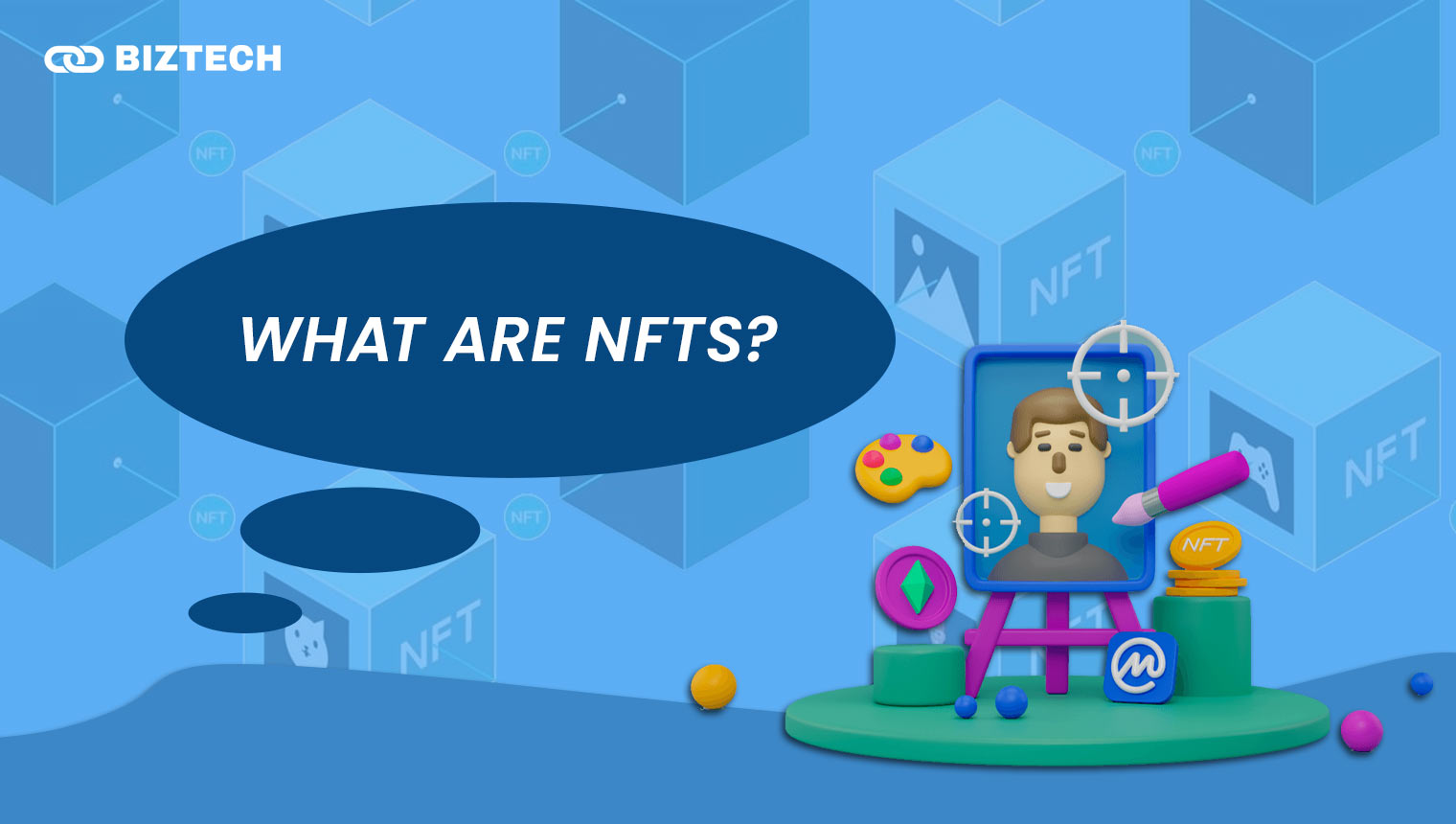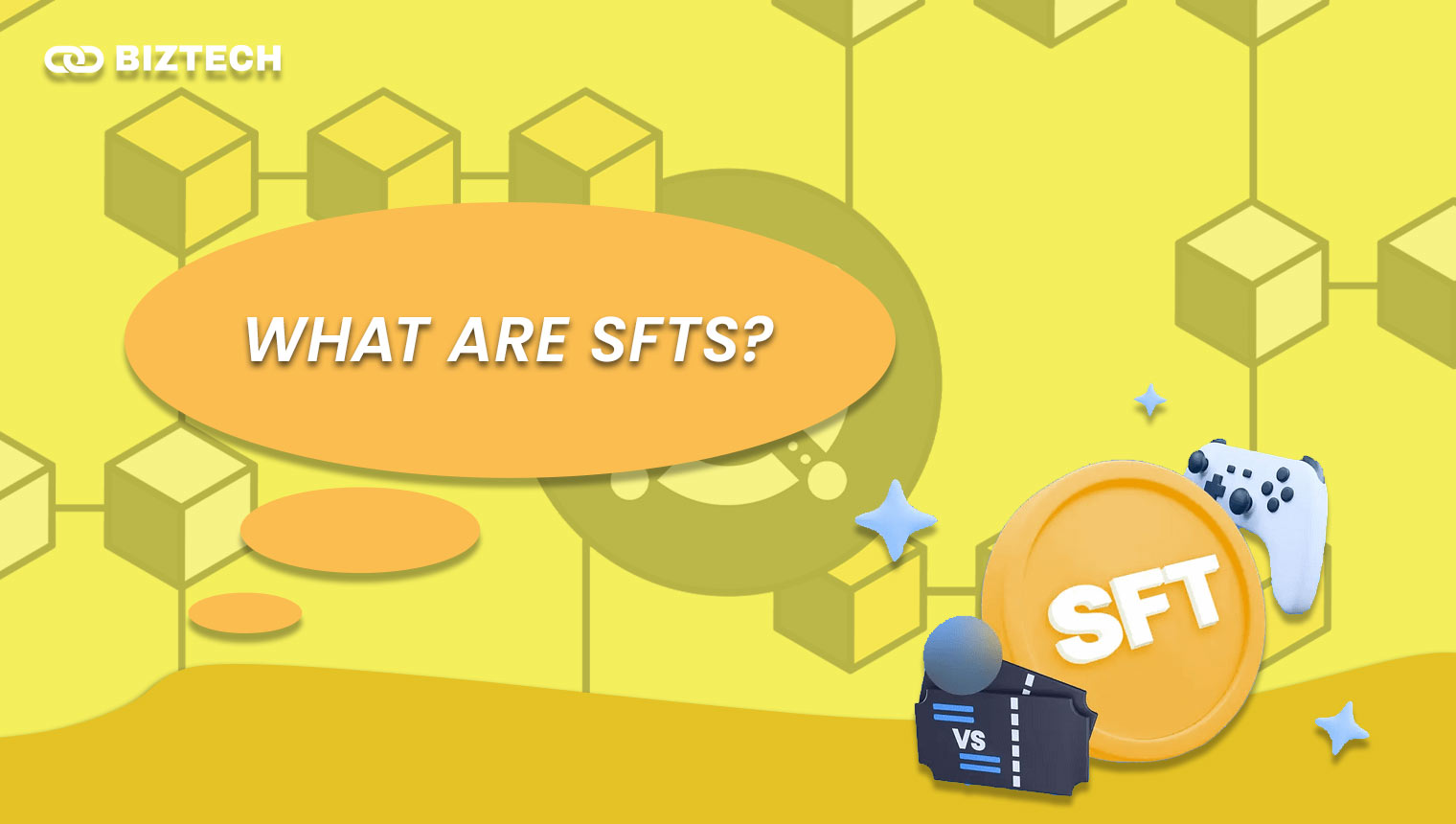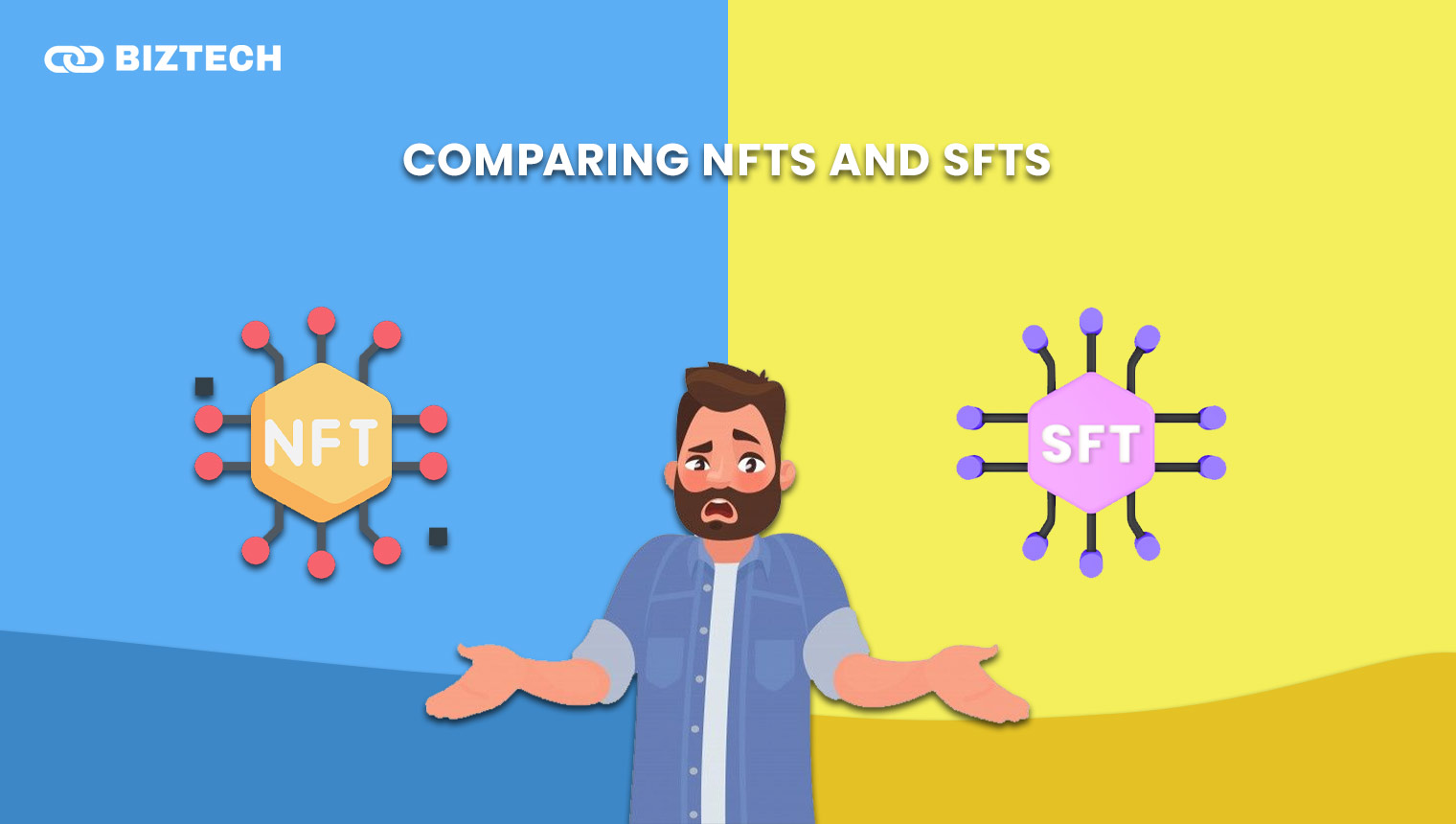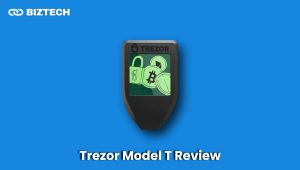Blockchain technology enables secure, decentralized transactions, whereas tokenization converts real-world assets into digital tokens.
- What are NFTs?
- Key characteristics of NFTs
- NFT Common uses and examples in various industries
- NFT Benefits and Problems
- What are SFTs?
- How SFTs differ from NFTs and traditional fungible tokens
- SFTs Potential uses with examples
- SFT Benefits and Problems
- Comparing NFT vs SFT
- Non-Fungible Tokens (NFTs) case studies:
- Semi-Fungible Tokens (SFTs) case studies:
- When to Use NFT vs. SFT
- Future Outlook and Innovations of NFT
- Future Outlook and Innovations of SFT
- Conclusion
- Frequently Asked Questions (FAQs)
Non-Fungible Tokens (NFTs) are unique digital assets for items such as art and collectibles, whereas Semi-Fungible Tokens (SFTs) combine unique and interchangeable properties, making them ideal for gaming items or memberships.
Understanding the distinction between NFT vs SFT is critical for asset identification, token selection, and informed investment decisions in the digital asset space.
What are NFTs?
Non-fungible tokens, or NFTs for short, are unique digital assets created using blockchain technology.
NFT is a non-fungible digital item. Non-fungibility means it is unique from other NFTs and cannot be exchanged.
Unlike cryptocurrencies like Bitcoin and Ethereum, they are fungible because as of this time of writing, 1 Bitcoin is equivalent to 20.60 Ethereum.
The core idea behind NFTs is digital scarcity and ownership. NFTs use blockchain technology to create verifiable digital scarcity and provide proof of ownership for digital assets.
Since every NFT is registered on a blockchain, it is possible to confirm the ownership and legitimacy of the asset.
Key characteristics of NFTs
- Uniqueness: Every NFT is a one-of-a-kind item that cannot be copied or reproduced.
- Indivisibility: NFTs are not divisible or fractionalized, unlike cryptocurrencies, which can be.
- Verifiable ownership: The blockchain technology that underpins NFTs creates a transparent and verifiable record of ownership, allowing for ownership transfers and origin tracking.
- Scarcity: Because NFTs have a limited supply, their perceived value and scarcity increase.
- Interoperability: NFTs can be purchased, sold, or traded on NFT marketplaces, resulting in a thriving ecosystem for digital assets.
- Programmability: NFTs can be programmed to include special features or attributes, like exclusive content access, royalties for the original creator, or integration with supported apps.
NFT Common uses and examples in various industries
Art and memorabilia
- The collage artwork, “Everydays: The First 5000 Days,” by Beeple, was sold for $69.4 million.
- Julian Assange, the founder of Wikileaks, and anonymous artist Pak sold Clock NFT in February 2022 for $52.7 million. The clock displays a timer counting the number of days Assange has been in prison.
- Bored Ape Yacht Club (BAYC) is an NFT that doubles as a collector’s item and a club membership identification. All the NFTs are the same cartoon apes but with variations of emotions, backgrounds, outfits, and accessories.
Identification and certification
- Duke University used NFT as a certificate for students in the Fintech program.
- The University of Georgia’s New Media Institute was one of the first to provide degree certificates in paper and NFTs.
NFT domain
- Unstoppable Domain is a one-stop shop for NFT domains, which are similar to domains with .com endings but with .crypto and .eth endings instead.
- In contrast to fee-based Web 2.0 domains, which must be renewed annually, Web 3.0 domains are one-time purchases. Additionally, NFT domains are user-owned. This means centralized companies like GoDaddy or Google Domains are unable to censor or seize control of them at will.
- Domain NFTs can also serve as cryptocurrency addresses, allowing the owner of the domain to send and receive payments in cryptocurrencies.
NFT Benefits and Problems
Benefits of NFTs:
- Ownership and Authenticity: NFTs offer a secure and transparent method for establishing ownership and authenticity of digital assets, which can be beneficial to artists, collectors, and creators.
- Monetization Opportunities: NFTs allow creators to monetize their digital works by selling them as unique assets and potentially earning royalties from secondary sales.
- Democratization of Art and Collectibles: NFTs can create new markets and opportunities for artists and collectors by simplifying the production, purchase, and sale of digital art and collectibles.
- Programmable Assets: NFTs can be customized with additional features or functionalities, such as smart contracts that distribute royalties or provide access to restricted content.
- Transparent Record of Ownership: The blockchain technology underlying NFTs makes a transparent and unchangeable record of ownership, provenance, and transaction history possible, which can boost confidence in the market.
Problems and Challenges with NFTs:
- Environmental Concerns: Minting and trading NFTs on blockchain networks such as Ethereum can be energy-intensive, raising environmental concerns.
- Speculative Bubble and Volatility: There are concerns regarding the sustainability and long-term worth of some NFT projects due to the substantial speculation and volatility in the NFT market.
- Legal and Regulatory Challenges: The legal and regulatory environment surrounding NFTs is still evolving, so there are many unanswered questions about intellectual property rights, taxes, and consumer protection.
- Fraud and Scams: There have been cases of fraud, scams, and rug pulls in the NFT space, which emphasizes the importance of exercising caution and due diligence.
- Scalability and Interoperability Issues: The scalability of blockchain networks and the lack of platform interoperability may be major obstacles to the widespread adoption and use of NFTs.
- Uncertainty around Value and Utility: NFTs allow users to own digital assets, but there are concerns about their long-term worth and usefulness beyond collecting and speculation.
What are SFTs?
Semi-fungible tokens, or SFTs for short, are a class of digital assets that combine features of non-fungible and fungible tokens.
The central idea behind SFTs is to offer a hybrid solution that combines the unique characteristics of non-fungible tokens (NFTs) with the divisibility and interchangeability of fungible tokens, such as cryptocurrencies.
How SFTs differ from NFTs and traditional fungible tokens
SFTs (semi-fungible tokens) are different from both NFTs (non-fungible tokens) and traditional fungible tokens in several ways:
Difference from NFTs:
- Divisibility: Unlike NFTs, which are indivisible and represent a single, unique asset, SFTs can be broken down into smaller units or fractions, allowing for partial ownership of the asset.
- Composability: SFTs can be combined or recombined with other SFTs of the same type to form a new, larger SFT that represents the entire asset. Traditional NFTs lack this kind of composability.
Difference from traditional fungible tokens:
- Uniqueness: SFTs represent unique assets with their own metadata, attributes, and properties, whereas traditional fungible tokens, such as cryptocurrencies, are interchangeable and indistinguishable from one another.
- Scarcity: SFTs, like NFTs, can be issued in limited quantities, creating scarcity and the potential for value appreciation. Traditional fungible tokens, such as Bitcoin and Ether, typically have a much larger supply.
- Programmability: Similar to NFTs, SFTs can be programmed to have extra features, smart contracts, or usage and transfer rules. Traditional fungible tokens are usually less programmable.
SFTs Potential uses with examples
Here are some real-world examples of how semi-fungible tokens (SFTs) could be applied:
- Real Estate: SFTs can represent ownership in real estate properties, enabling fractional ownership and shares trading. An SFT, for example, could represent a single apartment unit or a percentage of ownership in a commercial building. Investors could buy and sell fractions of the SFT, creating a more liquid and accessible real estate market.
- Art and Collectibles: SFTs can help with co-ownership and shared ownership of valuable artwork, collectibles, and other unique assets. An SFT could represent a well-known painting, with various investors owning different portions of the SFT, allowing for shared ownership and potential profit-sharing.
- Gaming Assets: SFTs may represent exclusive in-game items like armor, weapons, or digital real estate. Players could own, trade, and combine SFTs representing these assets, opening up new avenues for asset management and in-game monetization.
- Intellectual Property (IP): SFTs could represent intellectual property ownership and licensing rights, such as patents, copyrights, and trademarks. Fractions of the SFT may be sold, allowing various entities to invest in or license the intellectual property.
- Tokenized Stocks: SFTs have the potential to represent fractional ownership of a company’s stock or equity. This could make stock trading more accessible and liquid, as well as introduce a new approach to crowdfunding and equity crowdsourcing.
- Renewable Energy: SFTs may represent ownership in renewable energy projects like solar farms or wind turbines. Investors could purchase fractions of the SFT, allowing for greater participation in the funding and ownership of sustainable energy projects.
- Supply Chain and Logistics: SFTs can be used to track and manage physical asset ownership across a supply chain or logistics network. Each SFT may represent a distinct item or batch of goods, with fractions of the SFT representing partial ownership or custody at various stages of the supply chain.
SFT Benefits and Problems
Benefits of SFTs:
- Fractional Ownership: SFTs allow fractional ownership of unique assets, allowing various individuals to invest in or share asset ownership that would otherwise be too costly for a single entity.
- Increased Liquidity: SFTs enhance the liquidity of traditionally illiquid markets, like real estate or valuable collectibles, by allowing the fractional division and trading of assets.
- Democratization of Asset Ownership: SFTs can democratize asset ownership by allowing for smaller investments and lowering the entry barrier for individuals who were previously unable to participate in these markets.
- Programmability and Automation: SFTs, like NFTs, can be programmed with smart contracts to automate processes such as royalty distribution, profit sharing, and other asset-governing rules.
- Interoperability: SFTs can be designed to allow for cross-chain asset management and trading by enabling interoperability across various platforms and ecosystems.
Problems and Challenges with SFTs:
- Regulatory Uncertainty: The ongoing evolution of the legal and regulatory framework regarding SFTs and fractional asset ownership may create uncertainties and difficulties with compliance.
- Valuation and Pricing: It can be difficult to determine the pricing and fair value of the unique assets that SFTs represent, particularly when fractional ownership is involved.
- Governance and Decision-Making: Establishing governance mechanisms and decision-making processes for managing an SFT asset with multiple owners can be challenging.
Comparing NFT vs SFT
| Aspects | NFT | SFT |
| Interchangeability | Interchangeable | Partially interchangeable |
| Utility | Represent ownership and provenance | Represent assets that have varying degrees of fungibility and divisibility |
| Transferability | Transferable | Transferable |
| Uniqueness | Unique | Unique but only belongs to the particular collection, rather than at the individual level like NFT |
| Divisibility | Non-divisible | Divisible |
| Ownership | 1 owner | Multiple owners |
Interchangeability of NFT vs SFT:
- NFTs: Non-fungible tokens are distinct and non-interchangeable by design. It is impossible to exchange or replace one NFT for another of the same kind or value; each NFT represents a unique and indivisible asset. Because of this feature, NFTs are perfect for displaying distinctive digital assets like original artwork, collectables, or exclusive in-game items.
- SFTs: Tokens classified as semi-fungible are mostly interchangeable among members in the same collection. SFTs in the same collection are interchangeable, but they are not the same as SFTs in other collections. Within a single collection, this feature allows divisibility and fractional ownership.
Utility of NFT vs SFT:
- NFTs: The main purpose is to indicate the origin and ownership of unique digital assets. They make it possible to create digital ownership, scarcity, and authenticity in a variety of settings, such as gaming, art, and collectable digital goods.
- SFTs: Semi-fungible tokens symbolize assets with varying degrees of divisibility and fungibility. They enable fractional ownership and simpler ownership transfers by tokenizing real-world assets like stocks, commodities, and real estate.
Transferability of NFT vs SFT:
- NFTs: NFTs are intended to be easily transferred from one owner to another. The blockchain creates an open and unalterable record of ownership history.
- SFTs: SFTs are transferable between owners, just like NFTs. However, depending on the particular implementation and use case, the transfer process may involve extra verification or requirements, especially when it comes to fractional ownership or legal obligations.
Uniqueness of NFT vs SFT:
- NFTs: Every NFT is distinct on the blockchain and has a unique identifier. One of the main characteristics of NFTs is their uniqueness, which makes them appropriate for representing unique digital assets.
- SFTs: The collection is distinct from other collections, even though SFTs within the same collection are interchangeable. SFTs are distinct not at the level of the individual token but rather in the collection to which they belong.
Divisibility of NFT vs SFT:
- NFTs: NFTs are naturally indivisible. There is no way to split an NFT into smaller pieces or fractions; it represents a single, complete asset.
- SFTs: Semi-fungible tokens allow division within the groups to which they belong. Thanks to this divisibility, multiple parties can own shares or portions of the same SFT collection, allowing fractional ownership.
Ownership of NFT vs SFT:
- NFTs: NFTs make it easier to identify who owns the digital assets clearly. The blockchain maintains a transparent and verifiable record of an NFT’s ownership.
- SFTs: SFTs allow for multiple parties to own shares or portions of the same asset or collection, thereby representing fractional ownership of assets.
Non-Fungible Tokens (NFTs) case studies:
Digital Art and Collectibles (Uniqueness, Ownership):
The NFT piece “Everydays: The First 5000 Days” by digital artist Beeple sold in 2021 at Christie’s auction house for $69.3 million. With its distinctive digital collage of Beeple’s artwork, the NFT demonstrated the potential power to transform the art industry and make digital asset ownership possible.
Gaming and Virtual Worlds (Utility, Transferability):
The well-known blockchain-based game Axie Infinity represents unique in-game characters, or Axies, using NFTs. In the game, players can breed, gather, and trade these Axies as NFTs, establishing a robust virtual economy. What makes Axies valuable and collectible are their rarity and uniqueness.
Sports and Entertainment Memorabilia (Non-Interchangeability, Uniqueness):
Dapper Labs introduced NBA Top Shot, which lets fans buy and trade NBA highlights as NFTs. Every highlight is minted as an NFT, which distinguishes it as a distinct and authentic digital collectible. The platform has experienced tremendous growth; rare highlight NFTs have sold for millions of dollars.
Semi-Fungible Tokens (SFTs) case studies:
Real Estate Tokenization (Divisibility, Fractional Ownership):
Several businesses have looked into the tokenization of real estate assets using SFTs, including Propy and Overstock.com’s tZERO. This approach allows fractional property ownership, which makes the purchase and sale of real estate assets by investors more cost-effective.
Investment Funds and Asset Management (Transferability, Fractional Ownership):
To issue and manage SFTs that represent stocks, investment funds, or other financial assets, companies such as Polymath and Securitize have developed platforms.
Commodity Tokenization (Divisibility, Interchangeability):
Companies such as DigitalBits and Refinitiv have experimented with using SFTs to tokenize commodities like gold, oil, and agricultural products. By facilitating fractional ownership and simpler trading of these tangible assets, this strategy may increase investor access and liquidity.
When to Use NFT vs. SFT
Use NFTs when:
- If the asset you wish to showcase is truly unique and one-of-a-kind.
- If the asset cannot or should not be fractionalized into smaller units.
- It is critical to maintain clear and immutable ownership records for the asset, as well as trace its provenance and ownership history..
Use SFTs when:
- If the asset needs to be divided into smaller units or shares to accommodate fractional ownership.
- If the assets within a particular collection or category are interchangeable and fungible.
- If the asset or use case requires compliance with particular laws.
- If the primary goal is to increase the liquidity and traceability of previously illiquid assets.
Future Outlook and Innovations of NFT
Non-fungible tokens (NFTs) are evolving in response to trends such as fractionalized ownership, integration with virtual worlds, and a focus on environmental sustainability.
Future developments could include improved interoperability, dynamic NFTs, and smart contracts for royalty distribution.
These innovations will impact various industries, including arts and entertainment, gaming, finance, and real estate.
Overall, NFTs have the potential to revolutionize the digital economy by opening up new avenues for decentralized ownership, investment, and creative expression.
Future Outlook and Innovations of SFT
Semi-Fungible Tokens (SFTs) are on the rise, thanks to trends such as customizable ownership and DeFi integration. Future developments could include enhanced interoperability and dynamic SFTs.
These innovations will impact gaming, collectibles, and finance, specifically by allowing for customizable ownership in gaming, fractional ownership of real-world assets, and new opportunities in decentralized finance.
SFTs hold promise for ownership, investment, and creativity in the digital economy.
Conclusion
We have covered NFT vs SFT in-depth. Let’s recap.
NFTs are unique digital properties that prove ownership. They are commonly used for art, collectibles, and virtual real estate.
SFTs are a hybrid that combines distinct and interchangeable characteristics.
In contrast to traditional ownership models, NFTs and SFTs provide immutability, transparency, and increased liquidity in digital markets.
They allow creators to directly monetize their work, provide verifiable ownership, and create new opportunities for fractional ownership and trading, revolutionizing digital ownership and value exchange.
[su_box title=”Glossary of Terms on NFT vs SFT (Appendix)” box_color=”#e9ff8b” title_color=”#000000″ radius=”6″]
NFT: Non-Fungible Token is a unique digital possession stored on a blockchain that signifies ownership of a particular digital object or piece of content. It is commonly used for digital art, collectibles, and virtual real estate.
SFT: Semi-Fungible Token is a class of digital assets combining features of non-fungible and fungible tokens, enabling unique and interchangeable characteristics.
Cryptocurrencies: digital or virtual currencies that use cryptography for security and operate on their own without any central authority.
Blockchain: A decentralized, distributed ledger system that securely, transparently, and permanently records transactions between numerous computers.
Web 2.0: User-generated content, social media platforms, and interactive web applications define Web 2.0, the current iteration of the internet.
Web 3.0: The internet’s next evolution, focusing on decentralization, interoperability, and user control through technologies such as blockchain and decentralized protocols.
Cryptocurrency address: A unique string of alphanumeric characters used to send and receive cryptocurrencies over a blockchain network, similar to a bank account number.
Minting: The process of creating new tokens on a blockchain, which is frequently associated with NFTs. Artists or creators “mint” their digital assets onto the blockchain.
Rug pulls: A cryptocurrency scam tactic in which developers abandon a project after raising funds, stealing investors’ money and leaving them with worthless tokens.
[/su_box]









